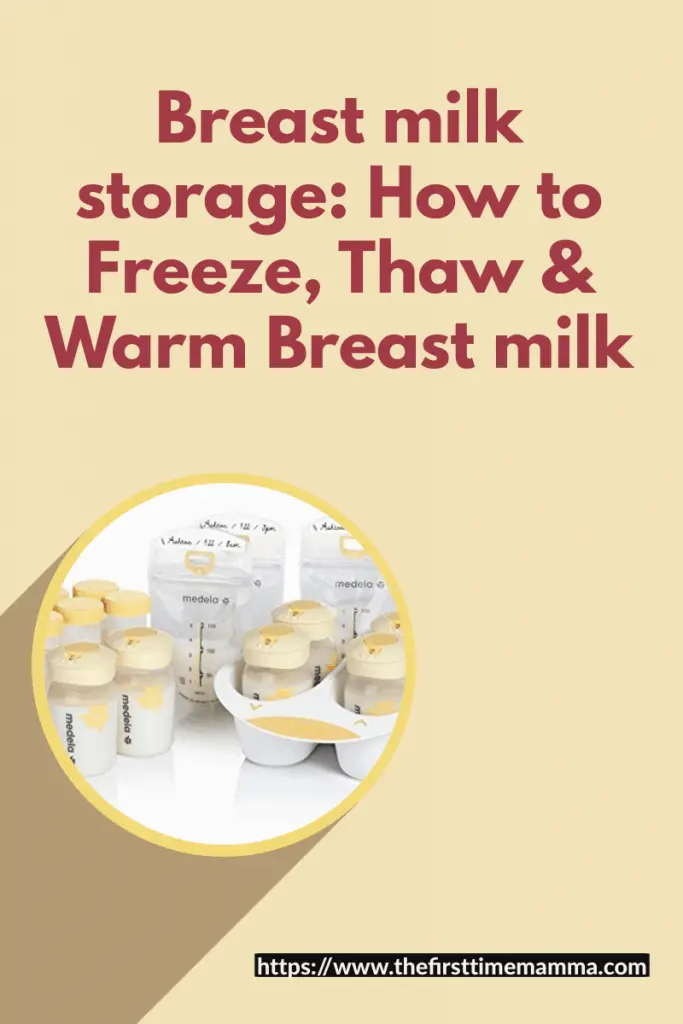If you’re planning on returning to work or thinking about joining that gym class to reduce those extra pounds or want your spouse to feed the baby for some time so you can get that much-needed sleep, then you should give pumping ago. With the help of a breast pump, you can express your breastmilk and save it for your baby to consume when you’re not around for nursing.
Hey! By the way… any links on this page that lead to products on Amazon are affiliate links and I earn a commission if you make a purchase. Thanks in advance – I really appreciate it! .
Expressed milk still has most of the benefits for the baby than other infant formulas. So, it’s better to give baby expressed milk when you’re not around during a feeding session. But the most important key is to store the milk safely while practicing best hygiene to ensure that the milk is free from any contamination. Given below are some tips for storing breastmilk properly.
Tips for freezing breast milk
- Before pumping, make sure that your hands and equipment are thoroughly washed. Label the expressed milk with proper date and utilize the old milk first. If you plan to donate your milk, then write your name on it as well so it becomes easier for the child care to distinguish.
- After each pumping session, pour the expressed milk immediately into a milk storage bag or any clean food storage container with tightly fitted lids. Make sure to leave at least a one-inch gap because liquids expand when they freeze.
- Store your milk in smaller portions of 2 to 4 ounces so they’re easier to thaw and use. This will also prevent your precious milk from going to waste in case your baby isn’t very hungry. You can easily fetch another milk and thaw and warm it in case your baby wants to have more.
- Place your milk at the back of the Freezer where it’s the coldest. Don’t place it in the freezer’s door. Only take out the milk when you’re ready to thaw it and use it as soon as possible. Don’t refreeze the milk that has been thawed.
- When you’re traveling, take insulated cooler bags with ice bags with you to store breastmilk after a pumping session. The milk can be kept in the cooler for 24 hours. Once you’ve reached your destination, your baby can consume the milk or you can store it in a refrigerator or freeze it immediately.
· Here’s a general guideline for storing breastmilk at different temperatures.
Guidelines for storing breastmilk at different temperatures
1) Room Temperature: Freshly expressed breastmilk can be placed at room temperature for about six hours. However, it’s optimal to properly store or consume the milk within four hours, especially during the summer when the temperature is warm.
2) Insulated Coolers: Freshly pumped milk can be stored in insulated coolers with an ice pack for about one day.
3) Fridge: Fresh milk can be stored at the back of the refrigerator for about five days. The fridge should be cool at 4 degrees Celsius and it should be clean and hygienic. It’s optimal to utilize the milk within three days.
4) Freezer: If it’s a freezer included in the refrigerator with a separate door, then freshly expressed milk can be stored for up to 9 months. If it’s a deep freezer, then the milk can be stored for up to 12 months. Though it’s optimal to utilize it within 6 months.
Tips for Thawing and Warming Breast milk
- You can thaw breastmilk by putting it in the fridge overnight or for up to 12 hours. Thawed milk can be placed in the fridge for up to 24 hours only. After that, it becomes prone to bacterial contamination. Any milk left after feeding the baby should be discarded within 1 to 2 hours. To warm this milk, put it under warm running water until it reaches body temperature. Check the temperature before offering it to the baby so it won’t burn their mouth.
- Frozen milk can also be thawed by placing in a warm water bath or a bottle warmer. This is the fastest method of thawing milk. Milk thawed using this method should be used within 2 hours.
- Use thawed milk within two hours after it has been left at room temperature. Discard it after two hours after the baby is fed to avoid bacterial contamination. Don’t refreeze the milk that has been thawed already.
- Thawing milk in a microwave isn’t recommended because it destroys the beneficial nutrients in the milk. Also, it may leave some hot spots in the milk due to an incontinent temperature which may end up burning the baby’s mouth.
- Your breastmilk may vary slightly in color depending on your diet. Also, thawed breastmilk might seem to have a different smell or consistency than freshly expressed milk. It’s still safe for consumption by your baby. If your baby refuses the thawed milk, shortening the storage time might help.
- Check the temperature of the milk before giving it to the baby. You can do this by squirting a few drops on the inside of your wrist. The milk should feel lukewarm or at room temperature. It shouldn’t be too cold or hot.
Storing breastmilk in your freezer for a rainy day can be quite a relief for the mother. Whether it’s just a few bags for an emergency or a proper stash in case you’re returning to work. It’s nice to know that your baby will still get that healthy nutritional milk even when you’re not there physically. But how you do it will make a lot of difference. How you thaw and use your frozen milk is just as important as how you store and collect it.
The guidelines provided on how to storing breastmilk above can help you in ensuring that your baby can have their milk healthy and safe. Also, please keep in mind that these guidelines are for healthy babies. If your baby is premature or is in a special ward or neonatal ICU, then your hospital may have more strict guidelines for storing breastmilk and cleaning.

